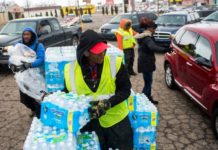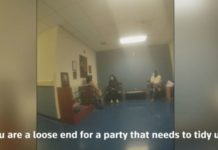While many in the United States celebrated a muted Thanksgiving over Zoom, millions of people traveled instead, rejecting the advice of public officials.
According to Transportation Safety Administration data, about 800,000 to one million people passed through T.S.A. checkpoints each day in the days before and after the holiday — far lower than the same period last year, but likely far higher than epidemiologists had hoped to see.
A United Airlines spokeswoman, Annabelle Cottee, said the week of Thanksgiving was “the busiest since March” for the carrier.
Americans also took to the roads. AAA predicted significant declines in bus, train and cruise travel, but predicted only a modest drop in car travel.
For several days leading up to Thanksgiving, as case numbers and hospitalizations across the country grew exponentially, political leaders and medical experts warned of the dangers of compounding the virus spread by being with others. In November alone, there have been more than 4.1 million cases and more than 25,500 deaths.
There were 91,635 current hospitalizations as of Nov. 28, according to the Covid Tracking Project, almost twice as many as there were on Nov. 1, and triple the number on Oct. 1.
Aware of the emotional resonance of the holiday, experts tried to thread a narrative from these numbers that would convince people of the danger. Their warnings were direct — sometimes stern, sometimes impassioned pleas.
“Keep the gatherings, the indoor gatherings as small as you possibly can,” Dr. Anthony S. Fauci, the nation’s top infectious disease expert, said on “Good Morning America” last week. By making that sacrifice, he said, “you’re going to prevent people from getting infected.”
The Centers for Disease Control and Prevention was also urging people not to travel. “All Americans want to do what they can to protect their loved ones,” Dr. Henry Walke, a Covid-19 incident manager at the C.D.C., said at a news briefing.
And though it would have been unrealistic to expect a public that is restive from months of restrictions to universally abide by such recommendations, the aftermath of those decisions will begin to unfold in the weeks ahead.
Dr. Fauci, during an appearance on the Sunday news program “This Week,” said the best course for Thanksgiving travelers might be “to quarantine yourself for a period of time.”
Dr. Deborah L. Birx, the White House coronavirus response coordinator, said that travelers “have to assume that you were exposed and you became infected and you really need to get tested in the next week.” She urged that travelers avoid anyone in their family over 65 or with underlying illnesses.
That guidance comes as the C.D.C. is considering shortening the recommended isolation period for infected people. And while it is too early to know if holiday travel will affect the virus’s spread, new research suggests that people are most infectious about two days before symptoms begin and for five days afterward, meaning this week will likely be crucial in containment.
On Monday, Mayor Bill de Blasio of New York City urged residents who had ignored official guidance and attended Thanksgiving gatherings to get tested.
In anticipation of a renewed demand, the city has opened 25 new testing locations in the last week. It will also now post online the wait times at its testing sites, which had seen growing lines as New Yorkers scrambled to get tests before their holiday plans.
The city’s seven-day average positive test rate was at 4.03 percent, Mr. de Blasio said, but he warned that the data may be skewed because fewer tests were conducted during Thanksgiving weekend.
“Some of our numbers may be skewed by that,” he said.
The U.S. map shows a country where almost every region is a hot spot. States that were once spared, like Montana and Wyoming, have reported record deaths and infections, while states that were pummeled in the first wave are straining anew.
On Sunday, California became the first state to report more than 100,000 cases in a week, according to a New York Times database.
And in New Jersey, hospitalizations have increased 60 percent in the last two weeks and deaths have increased by 78 percent. Over three days in November, the positivity rate in Newark, the largest city in the state, was 19 percent.
“We begged people to have a somber, respectful, small Thanksgiving,” Gov. Philip D. Murphy said on Fox News Sunday. “And I want to give a shout out to New Jerseyans because I think overwhelmingly that’s what happened, but there’s a lot of fatigue out there.”
Mr. Murphy called the next few months “the fight of our lives,” while also citing the progress of vaccines and noting that there was “light at the end of the tunnel.”
And there was something to celebrate on Sunday in New York City, at least for some parents, when Mr. de Blasio announced that he would reopen the city’s public elementary schools, abruptly shifting policy after an outcry from critics who questioned why gyms and bars remained open while schools were shut.
Source : Nytimes












